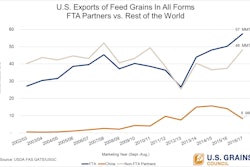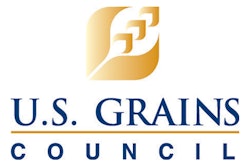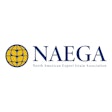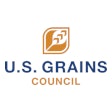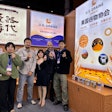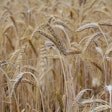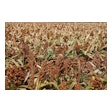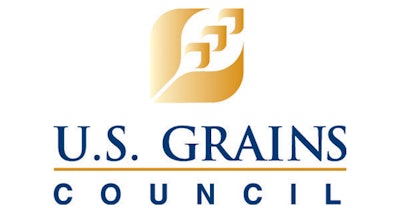
Seeing is often believing, which is why the U.S. Grains Council (USGC) brought corn and feed grain buyers from Egypt, Morocco, Algeria and Tunisia to the U.S. Corn Belt in September to talk firsthand with U.S. farmers and export suppliers.
|
The North Africa trade team visited a corn farm in Minnesota. Photo Credit: Minnesota Corn |
“These individuals represent the up-and-coming employees as managers or directors of the procurement departments of their companies,” said Ramy Hadj Taieb, USGC regional director for the Middle East and North Africa. “Bringing this team to the United States builds new and close relationships with these key corn importers as they become the leaders of their companies in future years to come.”
The grain procurement team traveled to North Dakota, Minnesota and Louisiana. As part of the tour, team members attended a grain procurement short course at the Northern Crops Institute in Fargo, North Dakota, to further improve their grain buying and pricing skills. They also toured grain export facilities in New Orleans, Louisiana, and met face-to-face in Minneapolis, Minnesota, with major U.S. corn export suppliers and the U.S. farmers who produce the corn they purchase.
The Middle East and North Africa (MENA) region includes a variety of growth opportunities for U.S. corn and co-products, but the region is very volatile. In addition, the United States faces ever-increasing, significant competition from Black Sea and South American exporters. To manage these dynamics and seize short-term market opportunities, the Council strives to be responsive to current market conditions by developing relationships and working to ensure importers are informed about U.S. crop availability and pricing.
“There is a constant need to increase awareness of origination and transportation to and through the U.S. export channels,” Taieb said. “Strong, ongoing relationships with key individuals and organizations can be catalysts for changes in policy, trading practices, demand and U.S. market share.”
The four countries represented on the team (Egypt, Morocco, Algeria and Tunisia) purchased 1.3 million metric tons (51.2 million bushels) of U.S. corn thus far in the 2016/2017 marketing year (Sept. 2016-July 2017). This includes sales of 871,000 tons (34.3 million bushels) to Morocco, the largest amount of U.S. corn exported to this free trade agreement partner since 2008/2009.
Significant opportunities also exist for U.S. distiller’s dried grains with solubles (DDGS). The four countries imported nearly 342,000 tons of U.S. DDGS to date in 2016/2017, a 57 percent increase year-over year. Both Morocco and Egypt are on track to import record levels of DDGS, with almost 183,000 tons and about 149,000 tons sold, respectively. Both countries will beat previous records set in 2010/2011.
Showing the importance of strong trade policy, since the United States-Morocco free trade agreement entered into force on Jan. 1, 2006, imports of U.S. corn have varied widely, but have recovered rapidly from a sharp decline ending in 2012/2013. DDGS imports, in contrast, have increased nearly 11-fold since the inception of the agreement.
Learn more about the Council’s work in the Middle East and North Africa here.




